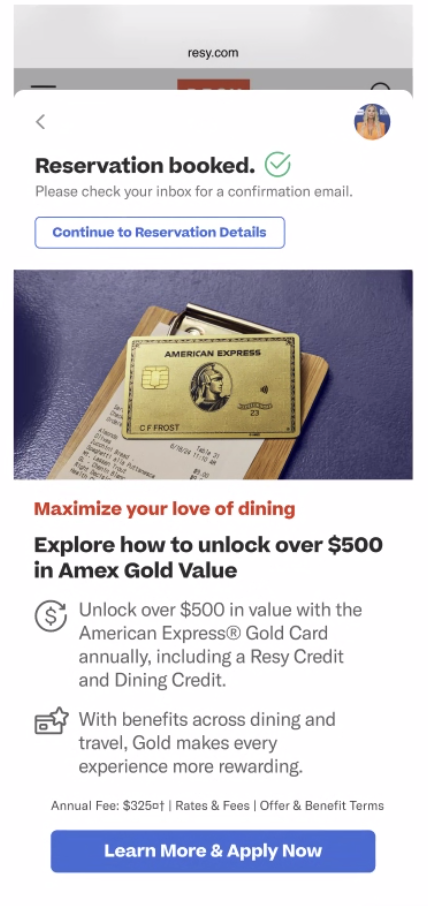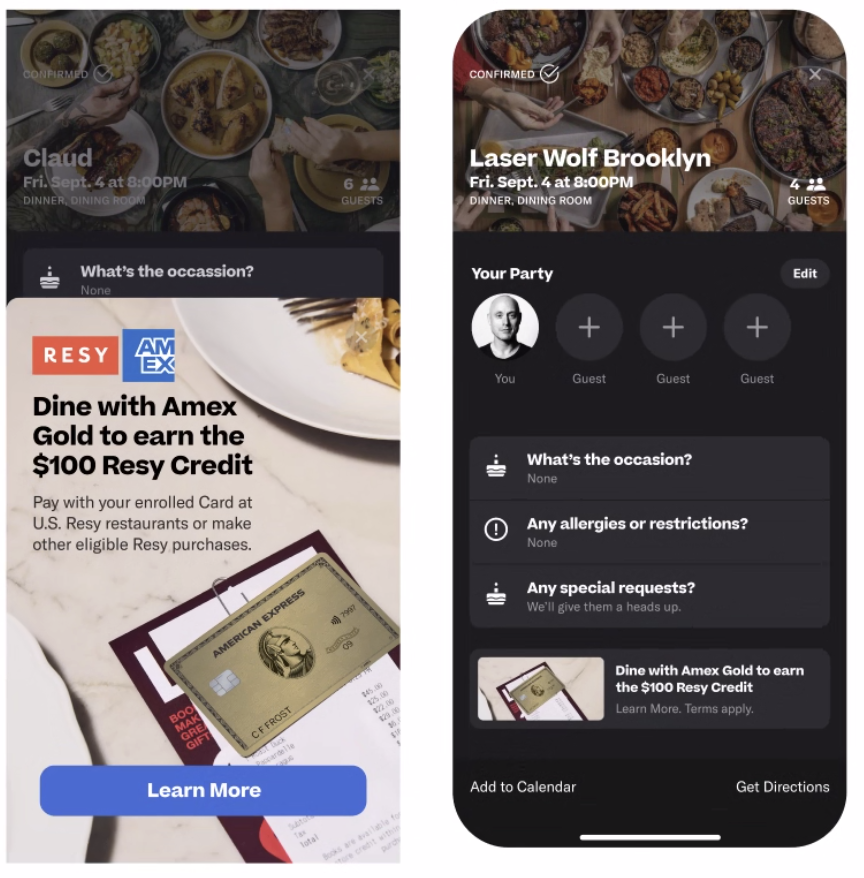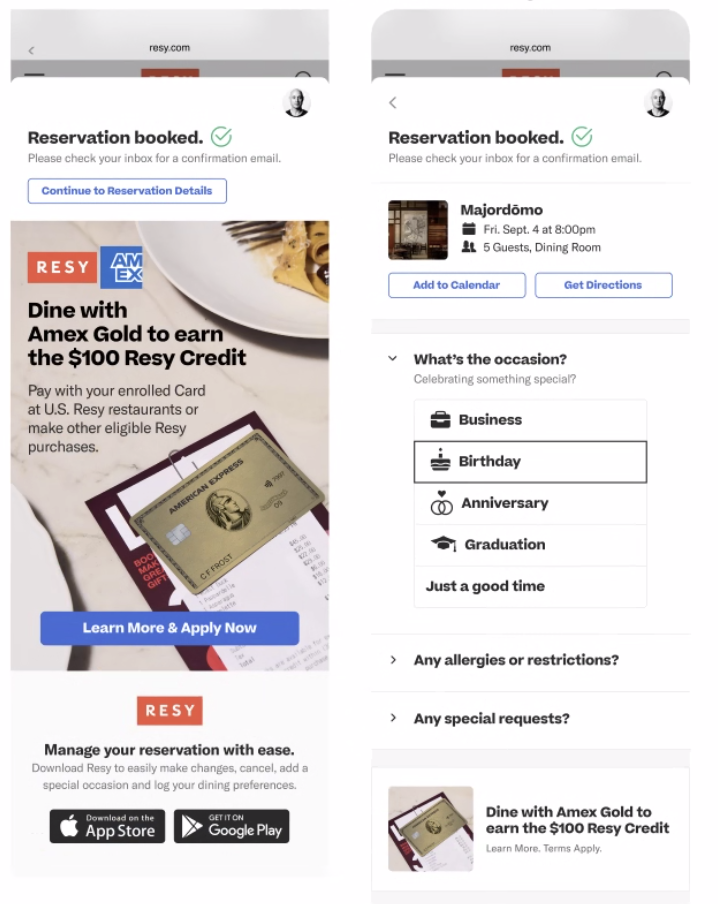Resy as an American Express Credit Card Acquisition Channel
In 2019, Resy was acquired by American Express, and more recently, a key business initiative has been integrating credit card acquisition experiences within the Resy ecosystem. With an ambitious goal of acquiring 100,000 new cardholders via Resy by 2027, this initiative plays a crucial role in Resy’s evolution as a strategic acquisition channel for Amex.
As the lead designer for consumer-focused New Account Acquisition (NAA) experiences, my role involves crafting seamless, engaging placements within Resy to drive awareness and conversion for Amex credit cards. Many Amex cards, including the Gold Card, offer valuable dining-related perks such as a $100 annual Resy credit, exclusive access to events, and priority tables—making Resy a natural place to promote them. For this project, our focus was on embedding a compelling Gold Card placement within the reservation booking flow and eventually utilizing this placement for other credit cards to be marketed as well.
Identifying the Right Placement
Our objective was to introduce an Amex Gold Card placement at a key moment in the user journey—without disrupting the core experience of making a dining reservation.
By analyzing user behavior data, we identified the optimal touchpoints:
In-app: We discovered that 70% of users complete the post-booking questionnaire on mobile, making it a prime opportunity to introduce the Gold Card placement without drop-off.
On web, only 4% of users complete this questionnaire, allowing us to place the NAA experience right before the confirmation screen, ensuring visibility without interruption.
To prevent overexposure, we implemented a frequency cap, limiting the ad to once per week for power users.
To target relevant users, we excluded those with an Amex Gold Card already stored in their digital wallet.
Since copy plays a pivotal role in engagement and conversion, I conducted a user survey to better understand what messaging resonates most. Key insights revealed that:
Users prefer monetary values over points-based benefits for clarity and impact.
Users need transparency on how the benefits are achieved to avoid confusion or skepticism.
With this in mind, I collaborated with Amex’s acquisition marketing team to refine our messaging. Given strict legal and compliance requirements, I ensured that our final copy adhered to regulations while remaining compelling and user-friendly.
Crafting the Right Message
Visual & UX Considerations
A key challenge was balancing Resy’s brand aesthetic with Amex’s established identity to create an ad that felt native to the Resy experience while maintaining Amex’s brand integrity.
I explored designs that focused on lifestyle imagery to align with Resy’s look and feel.
I tested versions with a stronger Amex presence to reinforce brand recognition.
After multiple iterations and feedback rounds, we landed on a hybrid approach that felt both premium and contextually relevant to dining.
Additionally, I worked closely with the Amex e-Apply team, which was responsible for the hybrid application page users landed on after clicking the CTA. While I wasn’t directly designing this page, I collaborated to ensure a seamless visual and UX transition from Resy to Amex.
Launch & Initial Learnings
We launched with the following:
A lifestyle image of the Amex Gold Card, reinforcing the premium dining benefits.
A snappy, high-value claim: “Explore How to Unlock Over $500 in Amex Gold Value.”
A clear, frictionless path to apply.
Over 1 million Resy users saw the placement monthly, proving strong visibility. However, conversion rates were lower than expected, prompting deeper research into user perceptions.
Application
Mobile Web
Desktop
To uncover insights, I conducted:
A survey and unmoderated usability study targeting engaged Resy users in key markets (NYC, LA, Chicago, Atlanta, DC, Philadelphia).
Participants walked through the booking experience, interacting with the placement and sharing thoughts on messaging and intent.
Findings revealed:
Users want clearer information upfront—many found “Unlock $500” vague and suspected fine print.
Users are highly task-focused when booking a reservation, making them less likely to engage with credit card offers at that moment.
Users prefer to research major financial decisions later, such as via email follow-ups or alternate placements within Resy.
Based on these insights, I proposed optimizations:
Introduce a “Remind Me Later” option, sending the offer via email or as a pop-up the next time the user navigates to Resy.
Test alternative placements, such as in the “Discover” tab or reservation confirmation page.
Refine messaging to highlight a singular, compelling benefit (e.g., “Get $100 Toward Your Next Dining Experience”).
User Research & Optimization
A/B Testing & Iteration
To validate our hypotheses, we conducted an A/B test:
Version A: Broad-value welcome offer (“Earn 20% back, up to $250 at restaurants”).
Version B: A refined, singular benefit message focusing on the $100 Resy credit.
The test results will guide further refinements and positioning strategies, ensuring Resy’s role in Amex’s acquisition funnel continues to evolve effectively.
Key Takeaways & Future Opportunities
This project reinforced the importance of:
Placing user needs at the forefront of acquisition strategies.
Ensuring financial product messaging is transparent, concise, and actionable.
Meeting users where they are in their journey—whether in-app, via email, or at a more decision-ready moment.
Moving forward, we’ll continue optimizing placements, refining messaging, and exploring additional opportunities within the Resy experience to engage users and drive meaningful conversions for Amex.





















